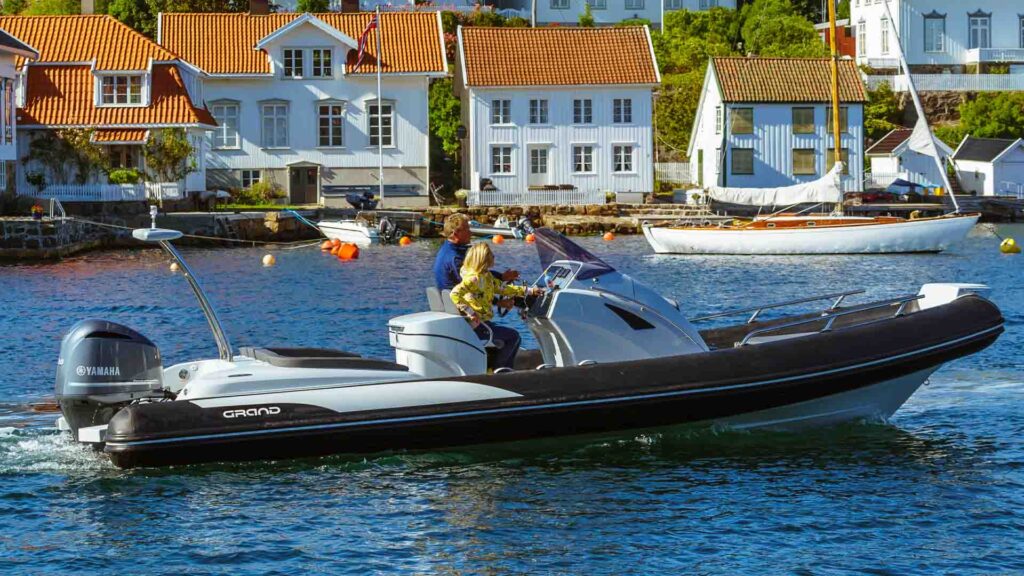RIB boats are becoming an increasingly popular choice amongst boat lovers across the globe. With their unique combination of rigid hull and inflatable tubes, rigid inflatable boats, or RIBs, are known for being incredible safe, seaworthy and high performance vessels, making these boats are a great choice for people who are new to boating, those looking for performance boats for watersports, fishing enthusiasts or those looking for leisure craft. RIBs come in many different sizes and designs – but what actually is a RIB boat? And is a RIB the right boat for you?
What does ‘RIB’ boat stand for?
RIB stands for ‘rigid inflatable boat’ and describes the appearance and design composition of these boats. You may also see these boats referred to as a ‘RHIB’, meaning ‘rigid hull inflatable boat’.
What does a RIB boat look like?
As the name suggests, these RIB boats – or rigid inflatable boats – are characterized by wide, inflatable tubes and a rigid hull – typically a medium-v or deep-v bottom hull.
What are rigid inflatable boats made of?
While the materials used for hulls and tubing on a RIB will vary depending on the manufacturer and the intended usage, RIBs are typically constructed using materials such as fiberglass or aluminum for the rigid hull, while the inflatable tubes are made of durable and UV-resistant fabrics, such as Hypalon or PVC. The combination of these materials results in a lightweight yet sturdy watercraft that can handle many different water conditions.
As previously mentioned, one of the key features of RIBs – or ‘rigid hull inflatable boat’ as they’re often referred to – is their deep V-shaped hull design, which allows for better handling and stability. This design, along with the inflatable tubes, provides excellent buoyancy and stability, making RIBs suitable for various water activities, including cruising, fishing, water sports, and even professional use in the military and rescue operations.
Fiberglass or aluminum boat?
The medium to deep-v hulls of a RIB boat are typically comprised of either aluminum or fiberglass. Aluminum RIBs tend to be cheaper and more lightweight making them easier to launch and transfer, however the hulls are more prone to scratches which can corrode quickly in saltwater environments. Fiberglass RIBs on the other hand are slightly heavier and so offer more stability and slower drifting in the water. Alongside providing a quieter ride in the water and a more attractive exterior appearance, are also easier to fix – such as when a small crack appears in the fiberglass hull – as only sanding and filling with gelcoat is required.
PVC or Hypalon inflatable tubes?
The inflatable tubes on a RIB are typically made of either PVC – which stands for ‘plastic vinyl coating’ – or Hypalon. Both tubing materials offer benefits, and your choice may just come down to your climate and intended usage. Regardless of material, high quality tubes will usually consist of five layers to ensure maximum air tightness, with the two external layers increasing the tubes’ resistance to UV and other external factors.
PVC materials are cheaper in price and repair, and often used in cooler climates where the tube material is easier to maintain.
Here at Grand Boats, our tube materials are typically hypalon combined with neoprene, which has an excelled chemical resistance and endurance against UV-rays, and is more stable, long-lasting and resistant compared to PVC. This material combination is especially popular for recreational rigid inflatable boats that are being used in regions with hot climates.
RIB Boat vs hard boat?
Rigid inflatable boats offer numerous advantages over conventional boats, making them an increasingly popular choice amongst boating enthusiasts.
Advantages of rigid inflatable boats:
-
- Safety: Safety should be a top priority for all boat users, and RIBs provide immense safety thanks to their design configuration, often more so than traditional boats. The combination of a rigid hull and inflatable tubes provides excellent stability and buoyancy, making RIBs highly resistant to capsizing. Even if a RIB takes on water, the inflatable tubes ensure that the boat remains afloat. Equally, in the rare instance where a RIB’s tubes become damaged or deflate, the multi-tube boat will remain afloat. At Grand Boats, our RIBs also feature handles, low-set seating, safe steps and non-slip decking to further improve safety on board. Of course, as with all boating, it is crucial that passengers have appropriate safety devices onboard with them, such as life vests and kill cords – to make their boating experience as safe as it can be.
-
- Stability & Maneuverability: With wide inflatable tubes that act as shock absorbers, and deep v-shaped hulls that cut through water conditions, RIB boats reduce the impact of waves and provide a smooth, stable and comfortable ride. Thanks to their lightweight design, rigid inflatable boats are also very responsive and so easy to handle and maneuver. The inflatable tubes make the boat very stable and act as shock absorbers, making pulling up to a dock or another vessel much easier. For these reasons, rigid inflatable boats – and in particular, Grand’s RIB boats – are a great choice for beginners and those wanting to learn boating. Smaller in size, our G340, G380 and G420 boats have proven popular choices for kids to learn boating on as well.
-
- Boat Weight: Thanks to their material composition, RIBs are known for being lightweight – more so than conventional hard boats – which comes with many benefits. More easier to transfer around, RIBs sit comfortably on trailers and are easy to tow. Additionally, the lightweight design of smaller inflatable boats – such as our range of small RIB boats – make for fantastic yacht tenders, as they sit lightly on the back of any vessel without adding any hindering weight.
-
- Versatility: One particular advantage that boat users find with RIBs is the versatility they offer. Thanks to their stable and seaworthy design, rigid inflatable boats are used across numerous activities, such as yacht tenders, recreational purposes, fishing, water sports and professional and commercial usage. At Grand Boats, our RIBs range from 3 metres to 9.5 metres in length and come in an array of layouts and configurations, enabling you to customize your boat to suit your requirements.
Read More: 10 Advantages of Rigid Inflatable Boats
Advantages of a hard boat:
-
- More floor space: Because they lack wide tubes, conventional hard boats tend to have slightly more floor space on the interior.
-
- Higher freeboard: While rigid inflatable boats tend to sit lower in the water, hard boats typically have a higher freeboard which may benefit the individual based on their usage intentions with the boat.
-
- Price: You may find that conventional hard boats come at a slightly lower price point than RIB boats. This of course depends on the individual configuration, brand and styling of your boat of choice.
Is a RIB boat right for you?
So, is a rigid inflatable boat the right choice for you? While your choice will come down to what you intend to use your boat for, it is clear that there are numerous advantages of RIB boats for boaters, whether they’re looking for a recreational boat, performance watersports boat, or commercial craft.
Rigid inflatable boats are growing immensely popular as a top choice for boating in Australia, and so if you need some more guidance on what a RIB boat is and whether it’s the right choice for you, please get in touch with us today.


